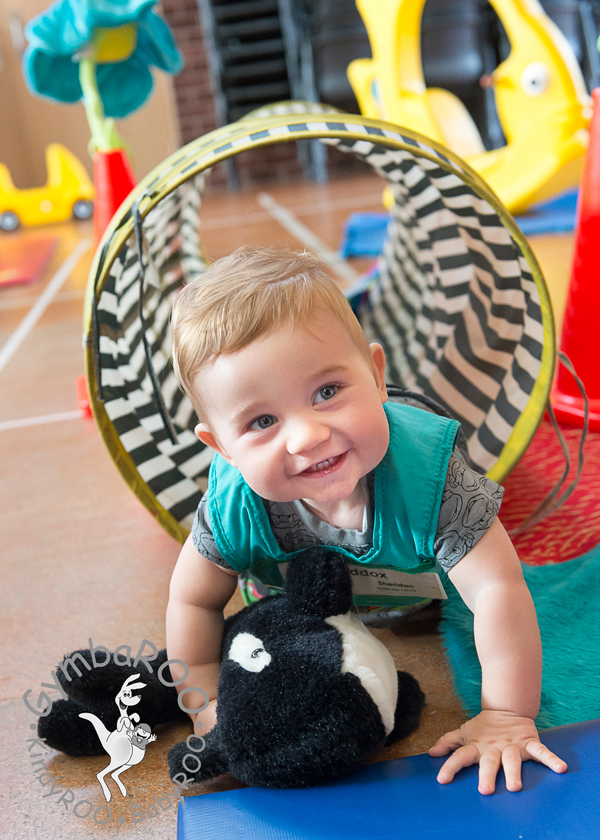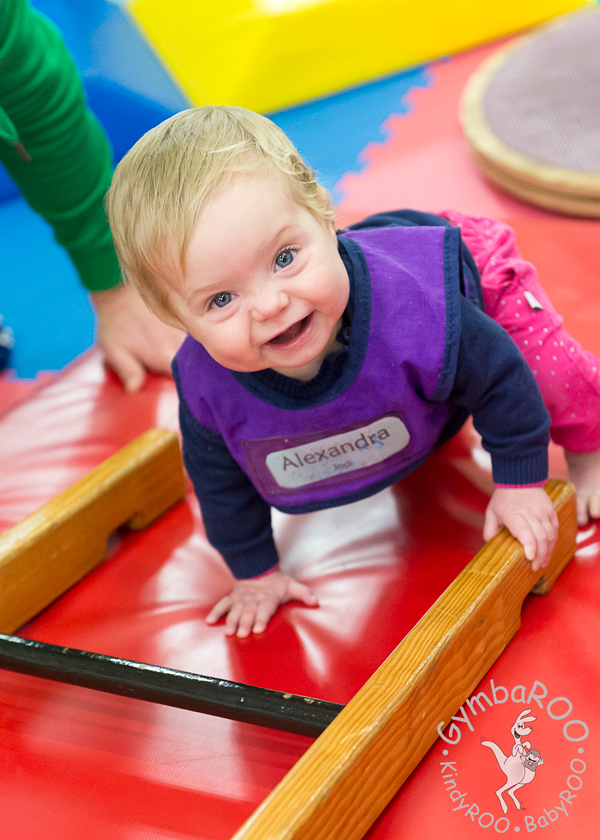Join the thousands of parents already raising smarter, happier babies with our online baby classes: The Active Babies Smart Kids series. Click here.
GymbaROO-KindyROO kids are excelling academically, emotionally, in leadership roles and on the sporting field. Find us at: GymbaROO-KindyROO
Dr Jane Willians and Bindy Cummings
Many of you will be well aware of our passion at GymbaROO for encouraging babies to crawl on their tummies and creep on their hands and knees. In this article we discuss the research that suggests that early crawling and creeping patterns play a very important role in the stimulation of vision and that this has a profound effect on how the body learns to control posture and balance before moving into the more challenging upright position.
Research undertaken by a team from the department of Kinesiology at San Francisco State University1 set out to investigate how the development of a certain motor development activity of babies – crawling along on the tummy – affected the development of later skills. They found that babies who engage in ‘tummy crawling’ (also referred to as ‘prone locomotion’) learn to control a number of necessary underlying tasks that assist with later upright posture and balance skills – namely steering, attending to the surface of support, and maintaining postural control. Much of this learning occurs as a result of stimulation to the visual system. As they drag themselves along, they are learning how to accommodate numerous visual and spatial variations. In other words, the brain is learning to differentiate between near/far, up/down, over/under, on/off, in/out and to respond by making postural adjustments. With the body well supported by the floor, the brain and body can learn to adjust posture without hazard of falling and can fine tune adjustments before the riskier business of learning to balance in an upright position.
Further research by a team from the Institute for Human Development in California2 also showed that the ground provides an important source of information for the control of posture and locomotion. They suggest that both tummy crawling and creeping on all fours are important for ‘getting the basics’ right as the visual messages about space are linked to postural responses. Interestingly, the peak time for this ‘visual-postural coupling’ is around 9 months of age – exactly when a baby is creeping.
Crawling and creeping not only promote the healthy development of visual and postural integration, it also provides important foundational brain pathways for many other visual-motor tasks. The smooth integration between what our eyes perceive, how the brain interprets those messages and responds via motor actions are essential for learning. A further study3 examined the importance of visual-motor skill integration in relation to learning at school. The results determined that good performance at visual-motor integration tasks is significantly related to academic performance in primary aged school children. So when babies are crawling and creeping they are putting into place the foundational skills for higher order thinking and learning. Read more here: Why creeping and crawling matter.
Research4 also draws our attention to the importance of experiences and opportunities in the early years of development, and how these experiences can affect ‘genetic expression’. It has been found that genes have multiple potential ‘switches’. These switches can be turned on or off, depending on the types of experiences a baby and small child have – a process called ‘epigenesis’. This means that one developmental acquisition produces experiences that bring about a host of new developmental changes in the same and different developmental areas, and this in turn has a flow on affect as we grow older. Several of the researchers suggest that babies who crawl on their tummies and creep on their hands and knees provide the brain with information that enables certain genetic possibilities that benefit later development and learning.
Encouraging your baby to crawl and creep
- Tummy time is the key to assisting tummy crawling. Try to give your baby lots of freedom and time to utilise the inbuilt reflexes that make them wiggle and squirm. They will eventually learn to push themselves forward along the floor. Watch GymbaROO’s free online video on Tummy Time with loads of tips and activities to help encourage happy tummy time.
- Babies who spend time on their tummies crawling will naturally pick their bellies up off the ground when they have inhibited the reflex that stops them from raising up against gravity. They will then rock backward and forward while on hands and knees and shake their heads to and fro. This inhibits another reflex, freeing them up to move – first by creeping backward, and finally forward! You can also encourage creeping by not sitting your baby up until they are ready to do it themselves. When you sit your baby up before they creep it takes away the desire to move, especially if you leave toys within reach! Some babies are so desperate to move that they shuffle along on their bottoms from this position and they never creep on their hands and knees.
Access GymbaROO-KindyROO’s online video on The Benefits of Crawling and Creeping. Access here.
Dr Jane Williams (PhD, BMgt, RN(Paeds)) is the Research and Education General Manager for GymbaROO and KindyROO. Dr Williams is one of Australia’s leading experts on baby and child development. More on Dr Williams here.
Bindy Cummings (B.Ed(Human Movement) Hons) has worked as a teacher, child development consultant, early childhood development lecturer, teacher trainer and INPP & iLS consultant. She is the co-creator of GymbaROO’s Active Babies Smart Kids online series, has authored many published articles on child development. She is working on the content and development GymbaROO’s portal and online training programs, and the creation of new online programs for parents and children. More on Bindy Cummings here.
GymbaROO Images by Studio Z Photography
References: 1. Anderson DI, Campos JJ, Anderson DE, Thomas TD, Witherington DC, Uchiyama I, Barbu-Roth MA. (2001). Linking Movement to visual development (including visual perception) Human Movement Science. 20(4-5):461-87 2. Lejeune L, Anderson DI, Campos JJ, Witherington DC, Uchiyama I, Barbu-Roth M. (2006). Responsiveness to terrestrial optic flow in infancy: does locomotor experience play a role? Human Movement Science. 25(1):4-17 3. Taylor Kulp, M. (1999). Relationship between visual motor integration skill and academic performance in kindergarten through third grade. Optometry and Vision Science. 76(3):159-63. 4. Meaney, M. (2010). Lifelong effects of good parenting: How experience affects gene expression. Paper presentation. Brain & Learning conference. Vancouver, Canada.
GymbaROO-KindyROO
Thousands of parents, babies and children are presently involved in our programs and creating rising stars. GymbaROO-KindyROO kids are excelling academically, emotionally, in leadership roles and on the sporting field. Come join all the fun and learning! “GymbaROO – The best decision I ever made for my child.” Classes from 6 weeks old – 7 years GymbaROO KindyROO
Active Babies Smart Kids – Online Baby Classes
GymbaROO-KindyROO’s online series of baby classes is taking the parenting world by storm! It is highly recommended by doctors, paediatricians, early childhood experts and the Maternal Child and Family Health Nurses Association. This series is being called: “The essential guide for parents”. Join the thousands of parents already playing with their babies from birth, in the best way for brain and body development and laying crucial foundations for future learning. What happens in the first year, not only matters, it matters a lot!
Click here: Active Babies Smart Kids online series of baby classes
Try the first episode FREE: Tummy time + baby fun and development class 1
Enjoy the following GymbaROO-KindyROO articles
GymbaROO-KindyROO: Who, what, where, why and how
All about GymbaROO-KindyROO’s online baby classes for parents and babies: Active Babies Smart Kids
How to raise a smarter, happier baby
Why creeping and crawling matter.
Why active babies make smart kids.
Tummy time for baby’s healthy development.
Baby milestones: A journey, not a race.
Please do not sit me until I can do it myself.
Beware over use of ‘containers’ – Why babies need the space and freedom to move.
‘Baby Seat’ devices and propping your baby to sit. Please avoid.
Bare feet for babies: Catching colds, trimming toenails and tips for first shoes.
Click here for more GymbaROO-KindyROO article choices





